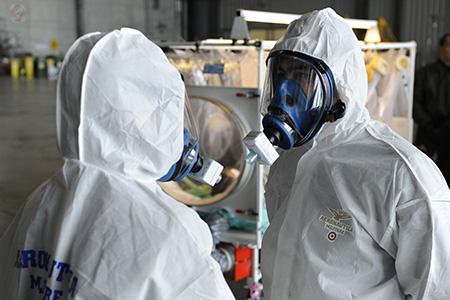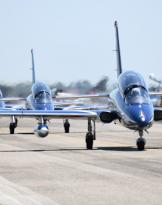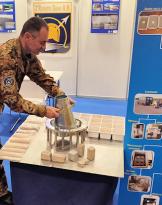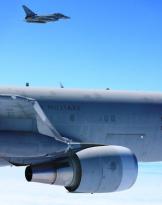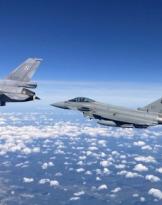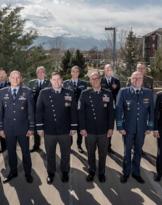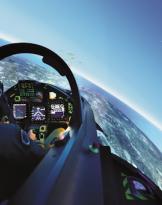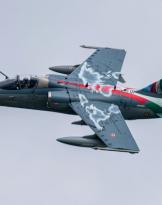Thirteen health workers of the Royal Netherlands Air Force (RNLAF), the Dutch air force, took part in the training activity organized by the Italian Air Force, a national and European leader in bio-containment transport capacity.
The course, requested by the Dutch armed forces themselves, is part of a training program that the Air Service of the Italian Air Force has long initiated at national level. The program includes a series of courses and exercises already carried out in collaboration with the Spallanzani Institute of Rome and the Sacco Hospital in Milan, to share the experiences gained in about a decade of studies and real operations as well as to consolidate a process of standardization on procedures linked to the management of emerging diseases among all the main realities, both civil and military, which in various capacities operate in the sector, particularly in the airport sector. The most recent training activity dates back to the first days of January, carried out in favor of medical personnel of the Navy; previously, however, the courses had been addressed to representatives of the Ministry of Health itself, 118 and the Italian Red Cross, and of other Armed Forces, Armed Corps of the State and representatives of the police.
The members of the Air Force Bio-containment Team, many of whom were on board the Boeing KC-767 that last November 25 reported Fabrizio Pulvirenti, the Emergency doctor infected with the Ebola virus in Sierra Leone, in Italy, provided to Dutch colleagues the technical knowledge and procedures for the use of isolated transport systems supplied to Italy, special negative-pressure stretchers that allow the transport and management of patients in total safety during the flight.
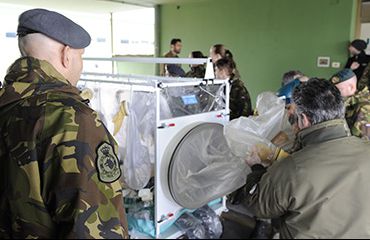 During the course - in addition to hints of a theoretical nature on the concept of bio-containment and the methods of transmission of particular biological agents and highly infectious diseases such as ebola, anthrax, smallpox - all the phases of embarkation / disembarkation from the aircraft were faithfully reproduced special aviation-transportable insulators and isolation and decontamination procedures used in the airport area.
During the course - in addition to hints of a theoretical nature on the concept of bio-containment and the methods of transmission of particular biological agents and highly infectious diseases such as ebola, anthrax, smallpox - all the phases of embarkation / disembarkation from the aircraft were faithfully reproduced special aviation-transportable insulators and isolation and decontamination procedures used in the airport area.
Experimented, moreover - in absolute preview - new and advanced systems of body temperature detection through special thermal cameras, one of the technologies on which all the major developed countries are aiming as an instrument of early discovery and management of potential infected cases in high concentration situations of people (such as airports). The initiative is the fruit of ongoing cooperation between the Air Force and the Institute of Research in Advanced Biomedical Technologies (IBAT) and the Department of Neuroscience of the University "Gabriele d'Annunzio" of Chieti.
The Air Force has developed this capacity for aero-medical evacuation since the 2005, through the acquisition of special systems called ATI - Aircraft Transit Isolators (of British patent). The capacity of air transport in bio-containment is a military capacity, available for civil use and purposes. It was, in fact, developed by the Air Force in coordination with both the Ministry of Health and with the Civil Protection, responsible for the patient's land transport and the management of national emergency health operations. The personnel in charge of the bio-containment transport activities ensures an on-call service that allows, at any time - 24 hours on 24, 365 days per year - to start the procedure very quickly. The aerial isolation unit that can be used for a sanitary evacuation in bio-containment consists of a number of specialists that can vary depending on the type of aircraft used and the type and level of threat present.
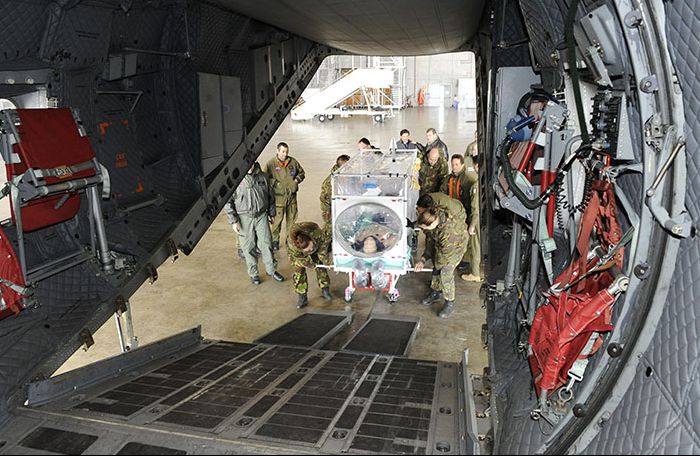
Source: AM - Public Information Office

